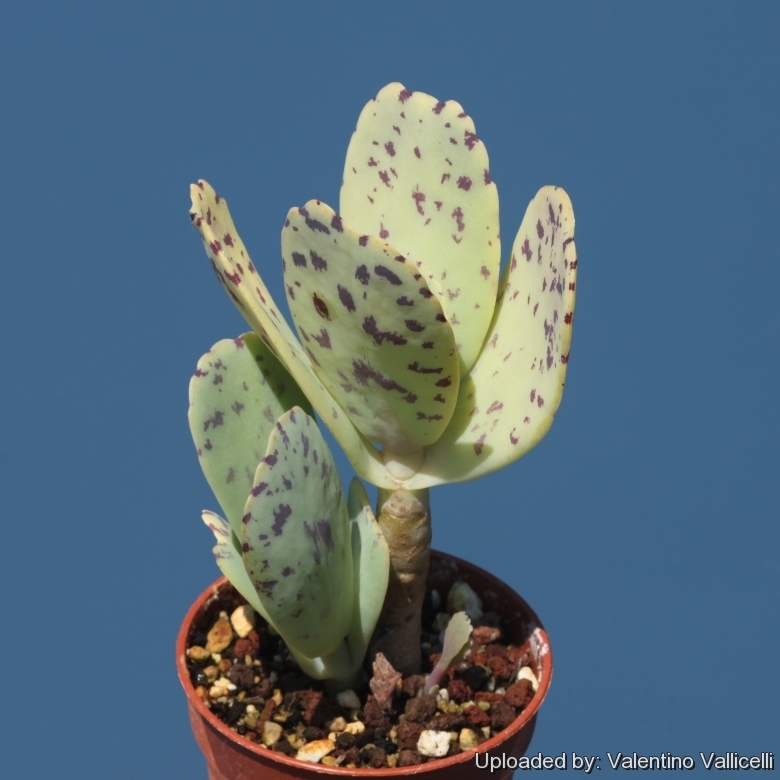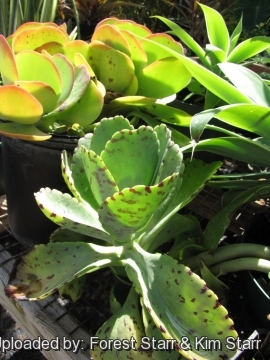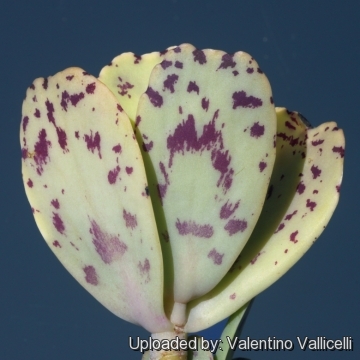
Kalanchoe marmorata Photo by: Valentino Vallicelli
Origin and Habitat: Kalanchoe marmorata (penwiper) is a species of flowering plant in the family Crassulaceae, native to Central and West Africa: Ethiopia, Erythrea, Somalia, Kenya, Sudan, Democratic Republic of Congo, Zaire, Rwanda and North Tanzania.
Altitude range: 1250–2400 metres above sea level.
Habitat: Grows on hill ridges where the drainage is excellent often in grasslands that are heavily grazed by cows, goats and sheep. On the most heavily grazed grassland, where only a few plants such as spiny acacias grow above the level of the closely cropped grasses, one can find K. marmorata with easily visible red flecks on its leaves. But the little damage seen on the kalanchoe leaves suggests that these plants are rarely even tasted, and one can at least offer the interpretation that these markings serve as warnings to day-feeding mammals.
Synonyms:
See all synonyms of Kalanchoe marmorata
back
Accepted name in llifle Database:Kalanchoe marmorata BakerGard. Chron. t. 12: 300 1892; et in Bot. Mag. (1894) t. 7333.Synonymy: 12
back
Common Names include:
ENGLISH: Penwiper Plant, Pen Wiper Plant, Spotted Kalanchoe, Penwiper, Baby Penwiper
Description: Penwiper plant (Kalanchoe marmorataSN|21214]]SN|21214]]) is a beautiful glabrous succulent herbs almost shrub-like 30-40 tall and wide, when it is growing in container, but it reaches 120 cm into the wild. It is named for its highly coloured leaves with brownish purple blotches, which look a little like blotting paper. The erect inflorescences grow up to 10 cm in length and bears delicate starry white, four-petalled flowers, sometimes tinged with pink, in spring.
Stems: Fleshy but rigid, upright or sprawling offseting from the base.
Roots: Fibrous and numerous.
Leaves: Sessile, paddle shaped (obovate) 5-20(–25)cm long and up to 13 cm wide, succulent rubbery to the touch, thick, glaucous yellow-greenish to blue-green or tan with spectacular brown or purple (or blackish) markings or veins on both surfaces, cuneate and semi-amplexicaul at the base, rounded at the apex. The spots become more pronounced when the plant is in sunny position. The margins are usually crenate or serrate (or rarely smooth). The leaves are soon lost from the lower parts of the plant.
Inflorescences: The flowers are borne in clumps (cyme) over 5 cm in spread, 10-30 cm long.
Flowers: Starry white, four-petalled, sometimes tinged with pink. Pedicels 15(–25) mm long. Calyx-lobes linear-triangular, 10–17 mm long, united for 1–2 mm. Corolla white, rarely flushed with pink; tube (45–)60–120 mm long; lobes 10–25 mm long, acute, mucronate. Upper anthers partly exserted. styles 30–80 mm long.
Blooming season: Blooms profusely from the end of winter to early spring.
Fruit: Four follicles 15–30 mm long with many seeds.
Remarks: The Kalanchoes are short day plants, they only bloom when they have less than 12 hours of light per day.
Chromosome number: 2n = 34, 68.
Notes: Kalanchoe marmorataSN|21214]]SN|21214]], is not the same plant as Kalanchoe grandiflora Wight & Arnott., which is sometiimes noted incorrectly as a synonym. Kalanchoe marmorataSN|21214]]SN|21214]] is a much larger plant with shorter uspotted turquoise green leaves and yellow flowers.
Bibliography: Major references and further lectures
1) Forest & Kim Starr “Kalanchoe marmorata (Spotted kalanchoe, penwiper plant)”. Plants of Hawaii. <http://www.starrenvironmental.com>. Web. 19 Oct. 2014.
2) Wikipedia contributors. "Kalanchoe marmorata." Wikipedia, The Free Encyclopedia. Wikipedia, The Free Encyclopedia, 25 Jun. 2013. Web. 19 Oct. 2014.
3) Edward E. Farmer “Leaf Defence” Oxford University Press, 17/Apr/2014
4) Fl. Pl. South Africa 27: t.1049 1948
5) Aloe 43[4]: 69-70 2006
6) Checklist Flow. Pl. Sub-Saharan Africa : 250 2006
7) “DK Eyewitness Travel Guide: Kenya: Kenya” Dorling Kindersley Ltd, 10/ott/2013
8) C. Broertjes “Application of Mutation Breeding Methods in the Improvement of vegetatively propagated crops” Volume 2 Elsevier, 02/Dec/2012
9) M. Thulin “Flora Somalia” Vol 1 1993 [updated by M. Thulin 2008]
10) Bernard Descoings: Kalanchoe grandiflora. In: Eggli: "Illustrated handbook of succulent plants." Crassulaceae: 2003
 - Habit at Kihei, Maui, Hawaii (USA). February 15, 2011. Photo by: Forest Starr & Kim Starr
- Habit at Kihei, Maui, Hawaii (USA). February 15, 2011. Photo by: Forest Starr & Kim Starr Kalanchoe marmorata Photo by: Valentino Vallicelli
Kalanchoe marmorata Photo by: Valentino VallicelliCultivation and Propagation: This is a very healthy plant and easy to grow. It need a fast draining mix, keep it were is bright, sunny, warm and airy, but protect from mid-day summer sun, water well during summer with dry periods between watering, during winter keep them rather dry, not completely. The leaves become redder with the cool nights of the winter, but will need protection from the cold during hard freezes
Reproduction: Cuttings or offsets in May or June, (when it is warm)












